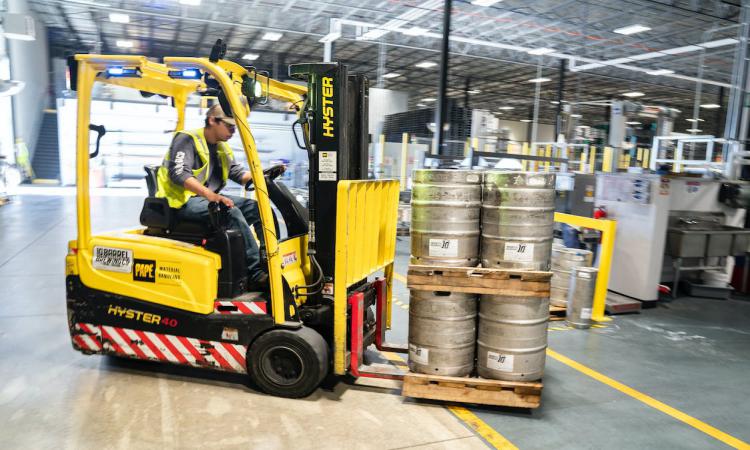 Introduction
Introduction
If you’re a warehouse manager, chances are that you’ve spent hours designing the layout of your warehouse. You’ve carefully considered which equipment will best suit your needs, and you’ve made sure that it’s all on hand and ready for use once your new facility opens. But did you know that there’s still one more step to complete before you can say your warehouse is fully operational? That’s right: creating an equipment list. Without a proper list of all the different types of equipment we just talked about (not to mention all their various specs), it’ll be impossible for anyone else—especially new employees—to know what we have or where they need to go when they need something in particular.
Warehouse equipment is only as good as the warehouse it’s in.
Safety is always a top priority for warehouses, and wooden pallets are the most common way to transport goods from one place to another. However, wooden pallets aren’t ideal for all industries and applications due to their flammability (especially when used with certain chemicals), so they must be replaced with plastic or metal alternatives.
Shelving and racking are some of the most obvious choices when it comes to warehouse equipment; however, they’re also among the most crucial. They help efficiently organize stock by providing easy access points and preventing overstocking at any point along your process.
Safety is the most important goal of any warehouse.
The most important goal of any warehouse is to keep everyone safe. This includes not only employees but also customers, visitors, and other workers. A good safety policy will reduce accidents, injuries, and health problems while increasing productivity overall. Safety equipment covers all areas of the warehouse, from forklifts to conveyors to storage racks.
Safety equipment can be expensive but it’s worth it: a healthy workforce makes for happy customers! Make sure your workers know how to use the protective gear provided so they can keep themselves safe while handling heavy loads or moving around machinery on their own (if permitted).
Wooden Pallets
Pallets are another must-have in a warehouse. When you’re dealing with large numbers of goods, pallets are a great way to store and transport them. They’re also perfect for warehouses that aren’t climate-controlled because they protect your products from the elements as well as secure them so they don’t break or fall over during transit.
When stacked correctly, wooden pallets like these wooden pallets in Brisbane can withstand heavy loads without collapsing or breaking apart, making them an ideal choice for storing heavy items that would otherwise take up more space if stacked on top of each other without protection. Wooden pallets also offer versatility: they can be used to transport goods by truck or train or even converted into furniture after they’ve served their purpose!
Shelving and racking are the most obvious choices when it comes to warehouse equipment, but they’re also the most crucial.
Shelving and racking are the most obvious choices when it comes to warehouse equipment, but they’re also the most crucial. They’re a warehouse’s backbone, providing easy access and optimal spacing for your inventory. Racks can be used to store items of various sizes and shapes at different heights, while shelves allow you to create a neat array of merchandise that enhances your product display.
Good Management System
In order to have a successful warehouse, you need to have a good management system. A good management system like these 3PL warehouses in Sydney is vital to the success of your warehousing business. You need to make sure that you have proper communication between your employees and yourself. You also need to make sure that you have the proper training for your employees so they know what they are doing. A good management system will help you keep track of your inventory, which is one of the most important things when it comes to running a warehouse business.
Different types of warehouses have different needs.
To understand how to choose the right warehouse equipment, it’s important to remember that not all warehouses are created equal. There are three main types of warehouses:
- Bulk storage facilities often have high-volume throughputs, so they rely on pallet racks and conveyor systems for efficient material handling.
- Delivery centers typically receive goods from suppliers, consolidate them into larger shipments, and then ship these out again. They use forklift trucks to move pallets and containers through their buildings quickly so they don’t get backed up with incoming or outgoing inventory.
- Distribution centers receive large shipments of goods from manufacturing plants or finished goods manufacturers and then divide those items into smaller quantities—often by item number—for delivery to retail stores or other customers (like you). These facilities need specialized equipment like automated storage/retrieval systems (AS/RS) to manage inventory efficiently while keeping costs down by minimizing manual handling operations needed during peak periods when demand is highest.
Trailers
Trailers are great for moving and storing items. They’re versatile, easy to use, and can be moved by forklift, pallet truck, or hand. Trailers like this welders trailer are available in many different sizes and materials with many accessories such as ramps, locking systems, and shelving options. If you need to move large items through your warehouse or around the backyard, a trailer is just right for the job.
Don’t forget about maintenance when you’re planning your equipment needs.
There’s something to be said for planning your equipment needs carefully. But it’s also important to think about maintenance, especially if you’re trying to cut costs. Equipment maintenance can be expensive on its own, and if you’re looking at how much it will cost in the long run (especially if you plan on keeping your warehouse up and running for years), then it makes sense to spend money on regular upkeep.
If properly cared for, cleaning equipment can prevent costly repairs down the line by ensuring that nothing gets out of whack or breaks unexpectedly when it really shouldn’t have broken yet. It may not sound like much, but taking care of these smaller things can help extend the life of an asset while also saving money at tax time when those assets are depreciating faster than usual due to wear and tear outside of regular use over time!
Never forget: If there aren’t qualified technicians on hand who specialize in keeping track of all these tasks regularly then everything else falls apart pretty quickly!
Listing out all your equipment needs can help create a successful warehouse plan
- Create a list of all the machinery, equipment, and other materials you’ll need to operate your warehouse.
- Get help from other people.
- Don’t forget to consider maintenance.
- Don’t forget to consider safety.
- Don’t forget to consider the needs of the warehouse. Certain safety features should be included in your equipment lists, such as emergency showers, fire extinguishers, and sprinklers in case something goes wrong with one of your machines or someone is injured at work (or during play). Also, keep in mind how much space each piece of equipment takes up; if it’s too big for where you’re planning on putting it then you may need some reconfiguration before purchasing anything new!
Conclusion
Now that you have an idea of what equipment you need, it’s time to start planning. You’ll want to consider all aspects of your warehouse environment and needs, from safety to the size and dimension of the space in which you’ll be placing any new equipment. Remember: a well-planned warehouse has everything it needs!




